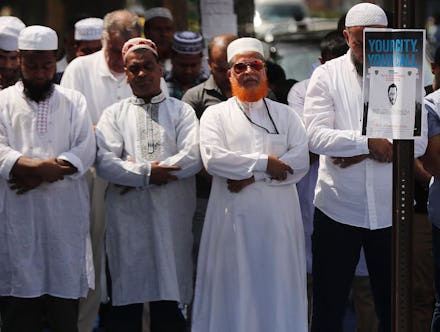Islamophobia in America is worse on 9/11/2016 than it was on 9/11/2001

On the evening of June 1, Mohamed Rasheed Khan — a 59-year-old Muslim man of Guyanese descent, and an American citizen — was leaving evening prayers at the New York Center for Islamic Studies in Queens, NY. As he mounted his bike, three men approached, chased and beat him, breaking bones in his face and leaving Khan with a concussion. He was unable to eat, speak or open his eyes.
"He was coming to pray, and Islam is all about love and caring for others," his niece, Asha Deopersaud told WABC 7. "The criminals that did this, they don't identify with that."
As the country reflects on the 15th anniversary of the Sept. 11 attacks, one would hope that bias-motivated crimes like the beating of Khan or the murder of Imam Alala Uddin Akongi and his assistant Thara Uddinwould would be fewer and farther between. In fact, since 2001, incidents of Islamophobia — which include attacks on members of the community, intimidation, anti-Muslim legislation as well as vandalism of mosques and Muslim businesses — have only increased in number and frequency; the highest spike in Islamophobic incidents came at the end of 2015, according to Muslim advocacy group the Council on American–Islamic Relations. In their 2015 analysis of FBI Crime Data, the Washington Post wrote that hate crimes motivated by Islamophobia was five times higher than pre-9/11.
It is a stark reminder that the public panic launched by 9/11 and subsequent attacks have normalized Islamophobic attitudes. Stoked by the hateful rhetoric of politicians like Donald Trump, Islamophobia is worse today than ever.
The anti-Muslim hate crime epidemic
Attacks on Muslim Americans have come in four waves since 9/11, said Corey Saylor, director of CAIR's department to monitor and combat Islamophobia. "For many Americans, 9/11 was their first interaction with Islam," Saylor said. "You'll see a sharp spike and then a settle period, but never back to what it was before 9/11."
Immediately after 9/11, there was a significant rise in anti-Muslim activity. According to the FBI, in 2001 anti-Islamic hate crimes spiked by 1,600 percent with 481 incidents. CAIR noted another surge in 2006 — the reason for it remains unclear. Another spike followed the Park51 controversy in 2010, in which New York City considered building a Muslim community center and mosque near Ground Zero.
But the highest concentration of anti-Muslim crimes came at the end of 2015. According to CAIR's latest report, 78 mosques were targeted for vandalism that year — more incidents than they had documented in any one year since they started tracking in 2009. Compare this to 2014, when CAIR only documented 22 similar incidents, or 2013, when they documented 20. The 2015 spike came after the attacks at the Charlie Hebdo headquarters in Paris and around the same time Donald Trump infamously proposed that the country should ban Muslims from entering until we "figure out what's going on."
Similarly, the Southern Poverty Law Center found that in 2014 while the rate of hate crimes overall had fallen compared with the previous year, hate crimes against Muslims saw a 14 percent increase.
Additionally, CAIR has documented at least 78 anti-Muslim bias groups. Perusing through the list, you see everything from "media monitoring groups" that purport to want effective and balanced coverage of the Middle East to groups that host discussions about violence against Muslims. Digging deeper, they found many of these groups have openly hostile views about Muslims. Taken together, these groups wield approximately $200 million dollars, giving them more power than one might think hate groups would have access to.
These numbers only reflect what has been corroborated through media or police reports, Saylor said. "If you walk into any mosque they'll tell you about at least 20 incidents." That's to say: Many instances of violence or desecration remain undocumented, so how truly pervasive these incidents are is unknown.
The media and politicians share a large part of the blame
Many of these incidents occur shortly after a terrorist attack or mass shooting. But CAIR has found that media portrayals of Muslims also feed Islamophobia.
"Muslim Americans have been at the forefront of helping citizens in Flint, Michigan get water, but you would never know that from the national coverage," Saylor said. "If one crazy person does something in Afghanistan, that's all over the news."
But perhaps what has been the most widespread manifestation of Islamophobia is the toxic rhetoric of our public officials. Trump has emerged as one of the most egregious examples of this phenomenon, routinely conflating the average Muslim American with radical Islam. He was joined by the other GOP candidates before the primary who routinely doubled down on anti-Muslim rhetoric when talking about national security, borders or the fight against terrorism. Trump's inflammatory rhetoric has played a huge part in stoking Islamophobia. He has emboldened one of the biggest causes of Islamophobia — ignorance.
As we mourn and remember the lives that were lost on Sept. 11, 2001, we must mourn the culture's continued victimization of its own Muslim citizens as well. We didn't just lose lives on 9/11. We lost some of our common decency. Whether it is Muslim places of prayer being attacked or Muslim Americans themselves being beaten and intimidated, we let the worst get a hold of us after Sept. 11.
The idea that America was ever a safe space for people who are deemed "outsiders" is an aspirational fiction, but it's impossible to deny the routine and public humiliation of Muslims goes against the grain of what this country was founded on. As a country founded on the motto, E pluribus unum — out of many, one — we should demand empathy for all Americans. The mainstreaming of Islamophobia signals the loss of something imperative to our democracy: our ability to see each other's humanity. And that is something to mourn on this somber day.